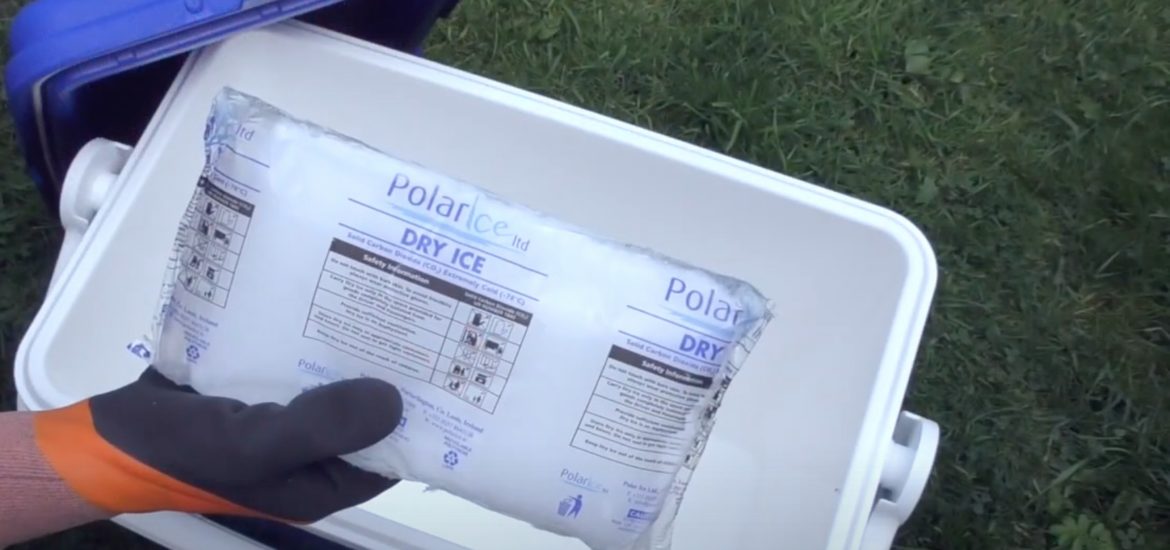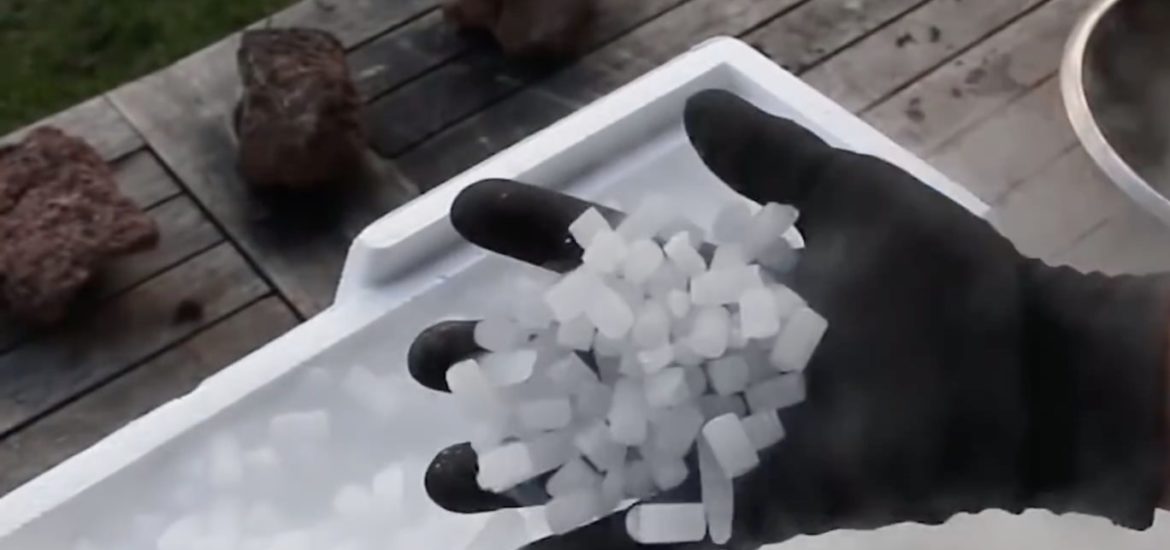Regular ice is the standard way of keeping things cold while camping, but what if you used dry ice instead?
Is dry ice better than regular ice for coolers? What are the benefits and drawbacks of using dry ice instead of regular ice?
Well, regular ice is convenient, widely available, and used almost exclusively by campers, but dry ice might just be what you’re looking for.
Article Contents:
What is Dry Ice?

Dry ice is solid, frozen carbon dioxide (CO2) as opposed to regular ice which is frozen water. As the name implies, dry ice doesn’t melt when exposed to room temperature or heat. Instead, it directly turns into gas, also known as “sublimation”.
Carbon dioxide freezes and remains frozen at a temperatures below -78.5⁰C (-109⁰F). On the other hand, regular ice freezes at temperatures below 0⁰C (32⁰F).
What are the Benefits of Using Dry Ice?
This massive difference in freezing temperature is what makes using dry ice for camping a great way to keep your food colder for longer.
- It won’t leave your food floating in liquid when it melts
- It’s great for keeping vegetables and fruits fresh without getting soggy
- As an interesting bonus, dry ice can also keep mosquitos away from your tent because mosquitoes are attracted to CO2 gas
But why isn’t this seemingly great alternative form of ice not common yet? Well, that’s because dry ice isn’t perfect – not to mention a bit hazardous if used improperly.
How Long Does Dry Ice Last?
One of the drawbacks of dry ice for camping is its shorter lifespan because they need to be stored in extreme temperatures. Storing dry ice in your freezer at home is both futile and dangerous.
- Dry won’t remain solid in a household freezer because the temperature doesn’t go low enough to keep it frozen
- There is also the risk of explosion due to the increase in carbon dioxide gas in the closed space
Since dry ice will start to sublimate immediately, always purchase it right before you head out for camping.
- On average, 2.5 to 5.0 kilograms of dry ice will last for around 24 hours or longer if properly insulated
If you are thinking how to keep food cold for longer while camping, using a combination of dry ice and regular ice. You can use dry ice to freeze your regular ice.
Once you run out of dry ice for camping, your regular ice will start to do the job. Just make sure you remove items that can become water-logged.
How Expensive is Dry Ice?
Dry ice is more expensive than regular ice. It comes in blocks or pellets and is usually sold by weight.
Dry ice costs between $3 to $6 per kilogram depending on the quantity being purchased.
Where Can You Buy Dry Ice for Camping?
Dry ice is definitely a bit more elusive, but if you get your (protected) hands on some it’ll be beneficial.
If you’re lucky, you might be able to purchase dry ice at major supermarkets like Costco or Walmart as well as other retail stores that are equipped with the required storage facilities.
If you can find a direct supplier of dry ice, it’s even better. In Canada, Dry Ice & Co. and Aqua Ice Inc. are two leading suppliers.
How to Use Dry Ice Properly When Camping

Dry ice is different from regular ice, and it’s vital to handle it cautiously. You can’t just toss it into a cooler, leave it in the sink, or ask your kid to carry it unsupervised.
But, as mentioned earlier, it can be very beneficial for a camping trip. So, here’s how to use dry ice properly to mitigate any potential risks.
Handling
Touching dry ice with your bare hands can burn your skin. Prolonged exposure can cause frostbite.
Don’t treat it like regular ice if you don’t want to lose your fingers. Always wear insulated gloves and long-sleeved clothing when handling it.
Packing
Never store dry ice for camping in airtight or plastic containers. The closed and confined space allows for a build up of gas pressure which can result in an explosion.
Here’s a how to arrange dry in a camping cooler effectively for best results:
- Wrap dry ice in newspaper before placing it inside the cooler. The newspaper creates a pseudo insulating layer to prevent unwanted direct contact.
- First, place regular ice at the bottom of the cooler and keep the food items on top of it.
- Organize the food items so that items that need to be frozen like meat are at the top, and items that need to be cold like drinks and eggs are at the bottom.
- Then, keep the paper-wrapped dry ice on top. You can add more crumpled newspapers to fill the gaps on top to delay the rate of sublimation. Dry ice that doesn’t contact water lasts longer.
Transportation
As dry ice sublimates, the increase in carbon dioxide in an enclosed space can be hazardous for your health.
Inhaling too much carbon dioxide can cause headaches, drowsiness, difficulty in breathing, and in the worst-case scenario, even death.
So, when transporting dry ice for camping in a cooler:
- Keep it away from passengers, ideally in the trunk of the vehicle
- Maximize the airflow in vehicles to flush out any carbon dioxide gas build up by opening windows and vents
- Open the cooler periodically to release the gas build-up inside the container
Pro-tip: If your cooler has a draining spout, keep it open to let out any carbon dioxide gas to prevent over-pressurization.
While Camping
- Keep it out of reach of small children and advise all campers on it’s safe and proper use (If you camp with children, I would recommend NOT using dry ice)
- Keep the dry ice some distance away from your tent to prevent accidentally inhaling too much CO2
- Remember to open the cooler every now and then to let the gas out
- Excess dry ice can be used to cool an open sitting area by placing it on the ground
This article contains affiliate links, which help support this blog at no cost to you!

Interesting article about dry ice. More people need to know this. Thanks for sharing
Absolutely, thanks for reading!